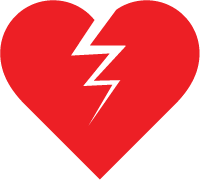The electrical system of the heart

The heart has an electrical system that synchronizes its contraction efficiently.
The upper chambers, the atriaThe atria are the two upper chambers of the heart. They act as reservoirs for blood that will fill the ventricles., must first contract to fill the ventricles in the lower part of the heart. These, in turn, will compress and, in an inescapable upward movement, spill their contents into the large vessels at the top.

An indispensable conductor
The band leader of this electric system is located in the upper part of the heart, next to the right atrium. A cluster of cells called the sinoatrial node is considered the pacemaker that controls the heart’s normal rhythm. It triggers the heartbeats and sets their frequency.

The normal number of heartbeats is estimated at between 60 and 100 per minute. However, it is quite predictable that heart rate will vary over a day. The heart beats more slowly when at rest, and speeds up during physical exertion or stress, for example.

Like a Wave Rippling Through the Water
The electricity generated by this cluster of cells, the sinoatrial node, is transmitted to the atriaThe atria are the two upper chambers of the heart. They act as reservoirs for blood that will fill the ventricles. and from there to the ventricles.
The electrical current delivered to the atria is reminiscent of the waves created by throwing a stone into water. The electrical “wave” travels from the sinoatrial node to the right and left atriaThe atria are the two upper chambers of the heart. They act as reservoirs for blood that will fill the ventricles..

A "Customs Officer" Between the Atria and Ventricles
Transmission between the atria and ventricles is possible at one point only. In this passageway lies the “electrical customs officer”, that is to say, another cluster of cells, this one called the atrioventricular node. With this right of access, electricity can flow from the atriaThe atria are the two upper chambers of the heart. They act as reservoirs for blood that will fill the ventricles. to the ventricles at a set maximum frequency.
The “customs officer” plays a vital role in certain cardiac rhythm disorders.

An Organized Electrical Transmission to the Ventricles
After passing through “customs”, electricity is transmitted to the right and left ventricles through 2 specialized electrical branches, the Purkinje network.

The Purkinje Network
The Purkinje network is like a highway that allows electricity to go through “customs” to the bottom of the ventricles at a very high speed.
By way of comparison, Hydro-Québec’s transmission lines supply electricity generated in northern Quebec to buildings thousands of kilometers to the south. This rapid transfer of the impulse steers the contraction from the bottom of the ventricles toward the exit. BloodBlood is composed of red blood cells, white blood cells, platelets, and plasma. Red blood cells are responsible for transporting oxygen and carbon dioxide. White blood cells make up our immune defense system. Platelets contribute to blood is thus expelled from the latter and lodged in the pulmonary artery and aorta through their respective valves.





















